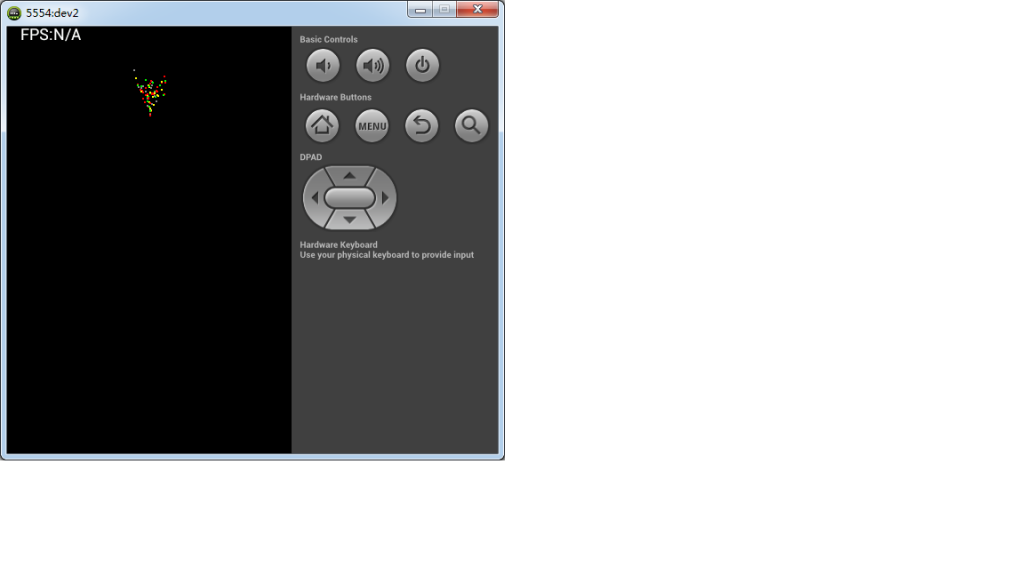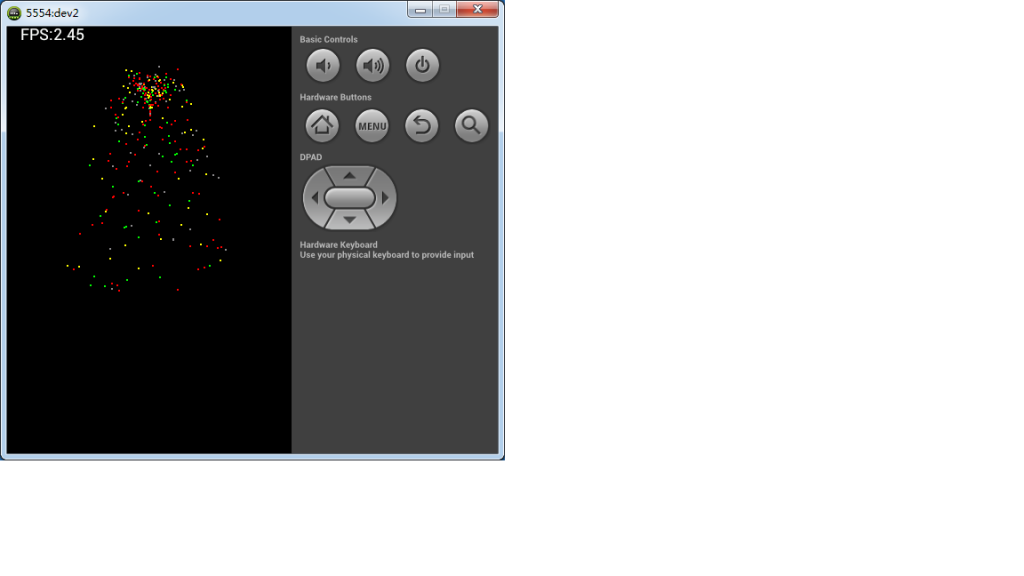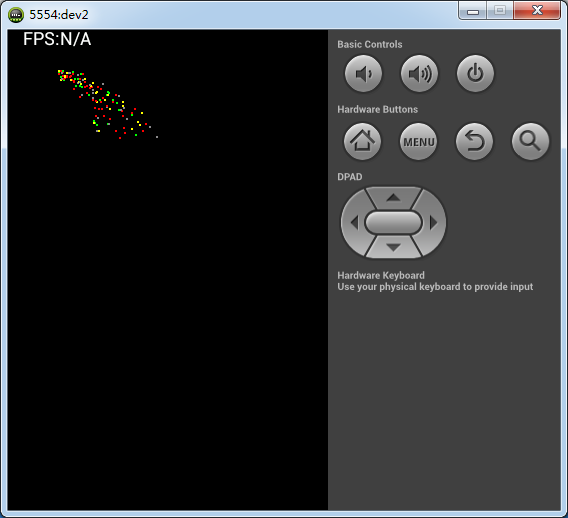本文实例讲述了android游戏开发学习②焰火绽放效果实现方法。分享给大家供大家参考。具体如下:
本节介绍在游戏开发中常用到的数学物理应用——粒子系统。粒子系统与上一节的小球有类似的地方,都是通过数学方法和物理公式模拟客观世界中的物体的运动轨迹。不同的是小球更强调个体运动,而焰火粒子等粒子系统更注重整体感觉。
一、焰火粒子效果
1.粒子对象类particle类和粒子集合类particleset类
每个粒子都为一个particle类的对象,程序中产生的所有particle对象都由一个particleset对象来管理。
particle类:
|
1
2
3
4
5
6
7
8
9
10
11
12
13
14
15
16
17
18
19
20
21
22
23
24
|
package com.particle; public class particle { int color; // 粒子颜色 int r; // 粒子半径 double vertical_v; // 垂直速度 double horizontal_v; // 水平速度 int startx; // 初始x坐标 int starty; // 初始y坐标 int x; // 实时x坐标 int y; // 实时y坐标 double starttime; // 起始时间 public particle(int color, int r, double vertical_v, double horizontal_v, int x, int y, double starttime) { super(); this.color = color; this.r = r; this.vertical_v = vertical_v; this.horizontal_v = horizontal_v; this.startx = x; this.starty = y; this.x = x; this.y = y; this.starttime = starttime; } } |
particleset类:
|
1
2
3
4
5
6
7
8
9
10
11
12
13
14
15
16
17
18
19
20
21
22
23
24
25
26
27
28
29
30
31
32
33
34
35
36
37
38
39
40
41
42
43
44
45
46
|
package com.particle; import java.util.arraylist; import android.graphics.color; public class particleset { arraylist<particle> particleset; public particleset() { particleset = new arraylist<particle>(); } /** * 向粒子集合中添加指定数量的粒子对象 */ public void add(int count, double starttime) { for (int i = 0; i < count; i++) { int tempcolor = this.getcolor(i); int tempr = 1; // 粒子半径 double tempv_v = -30 + 10 * (math.random()); // 随机产生粒子竖直方向的速度 double tempv_h = 10 - 20 * (math.random()); // 随机产生粒子水平方向的速度 int tempx = 160; int tempy = (int) (100 - 10 * (math.random())); // 随机产生粒子y坐标,90到100之间 particle particle = new particle(tempcolor, tempr, tempv_v, tempv_h, tempx, tempy, starttime); particleset.add(particle); } } /** * 获取指定索引的颜色 */ public int getcolor(int i) { int color = color.red; switch (i%4) { case 0: color = color.red; break; case 1: color = color.green; break; case 2: color = color.yellow; break; case 3: color = color.gray; break; } return color; } } |
产生的粒子竖直初速度为-30至-20,方向向上;水平初速度为-10至10,方向向左或向右。
2.物理引擎particlethread类
|
1
2
3
4
5
6
7
8
9
10
11
12
13
14
15
16
17
18
19
20
21
22
23
24
25
26
27
28
29
30
31
32
33
34
35
36
37
|
package com.particle; import java.util.arraylist; public class particlethread extends thread { boolean flag; particleview father; int sleepspan = 80; double time = 0; // 物理引擎的时间轴 double span = 0.15; // 每次计算粒子位移时采用的时间间隔 public particlethread(particleview father) { this.father = father; this.flag = true; } @override public void run() { while (flag) { father.ps.add(5, time); // 每次添加5个粒子 arraylist<particle> tempset = father.ps.particleset; // 获取粒子集合 for (int i = tempset.size() - 1; i >= 0; i--) { particle particle = tempset.get(i); double timespan = time - particle.starttime; // 计算从程序开始到现在经过的时间 int tempx = (int) (particle.startx + particle.horizontal_v * timespan); int tempy = (int) (particle.starty + 4.9 * timespan * timespan + particle.vertical_v * timespan); if (tempy > particleview.die_out_line) { // 如果粒子超过屏幕下边沿 tempset.remove(particle); } particle.x = tempx; particle.y = tempy; } time += span; try { thread.sleep(sleepspan); } catch (exception e) { e.printstacktrace(); } } } } |
本例中的物理引擎没有采用获取系统时间的方式,而是自己定义了一个时间轴(成员变量time)。这样可以自己确定时间轴行进的快慢程度(通过改变成员变量span的值),而不必依赖于系统的时间。
3.视图类particleview类
|
1
2
3
4
5
6
7
8
9
10
11
12
13
14
15
16
17
18
19
20
21
22
23
24
25
26
27
28
29
30
31
32
33
34
35
36
37
38
39
40
41
42
43
44
45
46
47
48
49
50
51
52
53
54
55
56
57
58
59
60
61
62
|
package com.particle; import java.util.arraylist; import android.content.context; import android.graphics.canvas; import android.graphics.color; import android.graphics.paint; import android.graphics.rectf; import android.view.surfaceholder; import android.view.surfaceholder.callback; import android.view.surfaceview; public class particleview extends surfaceview implements callback { public static final int die_out_line = 300; drawthread dt; particleset ps; particlethread pt; string fps = "fps:n/a"; public particleview(context context) { super(context); this.getholder().addcallback(this); dt = new drawthread(this, getholder()); ps = new particleset(); pt = new particlethread(this); } public void dodraw(canvas canvas) { canvas.drawcolor(color.black); // 清屏 arraylist<particle> particleset = ps.particleset; paint paint = new paint(); for (int i = 0; i < particleset.size(); i++) { particle p = particleset.get(i); paint.setcolor(p.color); int tempx = p.x; int tempy = p.y; int tempradius = p.r; rectf oval = new rectf(tempx, tempy, tempx + 2 * tempradius, tempy + 2 * tempradius); canvas.drawoval(oval, paint); // 绘制椭圆粒子 } paint.setcolor(color.white); paint.settextsize(18); paint.setantialias(true); canvas.drawtext(fps, 15, 15, paint); } @override public void surfacechanged(surfaceholder arg0, int arg1, int arg2, int arg3) { } @override public void surfacecreated(surfaceholder arg0) { if (!dt.isalive()) { dt.start(); } if (!pt.isalive()) { pt.start(); } } @override public void surfacedestroyed(surfaceholder arg0) { dt.flag = false; dt = null; pt.flag = false; pt = null; } } |
4.绘图类drawthread及activity类
基本与上节相同
drawthread类:
|
1
2
3
4
5
6
7
8
9
10
11
12
13
14
15
16
17
18
19
20
21
22
23
24
25
26
27
28
29
30
31
32
33
34
35
36
37
38
39
40
41
42
43
44
45
46
47
|
package com.particle; import android.graphics.canvas; import android.view.surfaceholder; public class drawthread extends thread { particleview pv; surfaceholder surfaceholder; boolean flag=false; int sleepspan=30; long start =system.nanotime(); //记录起始时间,该变量用于计算帧速率 int count=0 ; //记录帧数 public drawthread(particleview pv,surfaceholder surfaceholder) { this.pv=pv; this.surfaceholder=surfaceholder; this.flag=true; } public void run() { canvas canvas=null; while(flag) { try { canvas=surfaceholder.lockcanvas(null); //获取ballview的画布 synchronized (surfaceholder) { pv.dodraw(canvas); } } catch (exception e) { e.printstacktrace(); } finally { if(canvas!=null) { surfaceholder.unlockcanvasandpost(canvas); // surfaceholder解锁,并将画布传回 } } this.count++; if(count==20) { //计满20帧时计算一次帧速率 count=0; long tempstamp=system.nanotime(); long span=tempstamp-start; start=tempstamp; double fps=math.round(100000000000.0/span*20)/100.0; pv.fps="fps:"+fps; } try { thread.sleep(sleepspan); } catch (interruptedexception e) { e.printstacktrace(); } } } } |
mainactivity类:
|
1
2
3
4
5
6
7
8
9
10
11
12
13
14
15
16
|
package com.particle; import android.app.activity; import android.os.bundle; import android.view.window; import android.view.windowmanager; public class mainactivity extends activity { particleview pv; @override public void oncreate(bundle savedinstancestate) { super.oncreate(savedinstancestate); requestwindowfeature(window.feature_no_title); //设置不显示标题 getwindow().setflags(windowmanager.layoutparams.flag_fullscreen, windowmanager.layoutparams.flag_fullscreen); //设置全屏 pv=new particleview(this); setcontentview(pv); } } |
效果图:


二、瀑布粒子效果
瀑布粒子和焰火粒子十分类似,二者的运动都是带有初速度的下落运动。所不同的是焰火粒子水平方向和竖直方向的速度均不为零,而瀑布粒子只有水平方向初速度,竖直方向初速度为零。只需在焰火粒子的生成部分particleset类中修改即可。
particleset类add方法修改如下:
|
1
2
3
4
5
6
7
8
9
10
11
12
13
14
15
16
|
/** * 向粒子集合中添加指定数量的粒子对象(瀑布粒子效果) */public void add2(int count, double starttime) { for (int i = 0; i < count; i++) { int tempcolor = this.getcolor(i); int tempr = 1; // 粒子半径 double tempv_v = 0; // 粒子竖直方向的速度为0 double tempv_h = 10 + 20 * (math.random()); // 随机产生粒子水平方向的速度 int tempx = 50; int tempy = (int) (50 - 10 * (math.random())); // 随机产生粒子y坐标,90到100之间 particle particle = new particle(tempcolor, tempr, tempv_v, tempv_h, tempx, tempy, starttime); particleset.add(particle); } } |
效果图:


希望本文所述对大家的android程序设计有所帮助。














